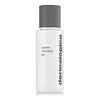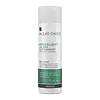What's inside
What's inside
 Key Ingredients
Key Ingredients

 Benefits
Benefits

 Concerns
Concerns

 Ingredients Side-by-side
Ingredients Side-by-side

Water
Skin ConditioningSodium C14-16 Olefin Sulfonate
CleansingSodium Lauroyl Sarcosinate
CleansingButylene Glycol
HumectantHydroxyethylcellulose
Emulsion StabilisingLavandula Angustifolia Oil
MaskingQuillaja Saponaria Bark Extract
CleansingCitrus Limon Peel Oil
MaskingMelissa Officinalis Leaf Extract
Skin ConditioningCitrus Aurantium Bergamia Fruit Oil
MaskingCymbopogon Nardus Oil
MaskingGlycerin
HumectantCocamidopropyl Betaine
CleansingSodium Cocoamphoacetate
CleansingHydroxyacetophenone
AntioxidantCocamidopropyl Hydroxysultaine
Cleansing1,2-Hexanediol
Skin ConditioningCaprylyl Glycol
EmollientPropanediol
SolventCitric Acid
BufferingO-Cymen-5-Ol
AntimicrobialDisodium EDTA
PPG-5-Ceteth-20
EmulsifyingSodium Hydroxide
BufferingSodium Benzoate
MaskingWater, Sodium C14-16 Olefin Sulfonate, Sodium Lauroyl Sarcosinate, Butylene Glycol, Hydroxyethylcellulose, Lavandula Angustifolia Oil, Quillaja Saponaria Bark Extract, Citrus Limon Peel Oil, Melissa Officinalis Leaf Extract, Citrus Aurantium Bergamia Fruit Oil, Cymbopogon Nardus Oil, Glycerin, Cocamidopropyl Betaine, Sodium Cocoamphoacetate, Hydroxyacetophenone, Cocamidopropyl Hydroxysultaine, 1,2-Hexanediol, Caprylyl Glycol, Propanediol, Citric Acid, O-Cymen-5-Ol, Disodium EDTA, PPG-5-Ceteth-20, Sodium Hydroxide, Sodium Benzoate
Water
Skin ConditioningGlycerin
HumectantSodium Laureth Sulfate
CleansingSodium PCA
HumectantSodium Lactate
BufferingGlycine
BufferingFructose
HumectantUrea
BufferingNiacinamide
SmoothingInositol
HumectantLactic Acid
BufferingAllantoin
Skin ConditioningSodium Hyaluronate
HumectantPEG-7 Glyceryl Cocoate
EmulsifyingSodium Methyl Cocoyl Taurate
CleansingXanthan Gum
EmulsifyingTriethanolamine
BufferingCarbomer
Emulsion StabilisingBenzophenone-3
UV AbsorberSodium Hydroxymethylglycinate
PreservativePropylparaben
PreservativeMethylparaben
PreservativeSodium Benzoate
MaskingWater, Glycerin, Sodium Laureth Sulfate, Sodium PCA, Sodium Lactate, Glycine, Fructose, Urea, Niacinamide, Inositol, Lactic Acid, Allantoin, Sodium Hyaluronate, PEG-7 Glyceryl Cocoate, Sodium Methyl Cocoyl Taurate, Xanthan Gum, Triethanolamine, Carbomer, Benzophenone-3, Sodium Hydroxymethylglycinate, Propylparaben, Methylparaben, Sodium Benzoate
 Reviews
Reviews

Ingredients Explained
These ingredients are found in both products.
Ingredients higher up in an ingredient list are typically present in a larger amount.
Glycerin is already naturally found in your skin. It helps moisturize and protect your skin.
A study from 2016 found glycerin to be more effective as a humectant than AHAs and hyaluronic acid.
As a humectant, it helps the skin stay hydrated by pulling moisture to your skin. The low molecular weight of glycerin allows it to pull moisture into the deeper layers of your skin.
Hydrated skin improves your skin barrier; Your skin barrier helps protect against irritants and bacteria.
Glycerin has also been found to have antimicrobial and antiviral properties. Due to these properties, glycerin is often used in wound and burn treatments.
In cosmetics, glycerin is usually derived from plants such as soybean or palm. However, it can also be sourced from animals, such as tallow or animal fat.
This ingredient is organic, colorless, odorless, and non-toxic.
Glycerin is the name for this ingredient in American English. British English uses Glycerol/Glycerine.
Learn more about GlycerinSodium Benzoate is a preservative. It's used in both cosmetic and food products to inhibit the growth of mold and bacteria. It is typically produced synthetically.
Both the US FDA and EU Health Committee have approved the use of sodium benzoate. In the US, levels of 0.1% (of the total product) are allowed.
Sodium benzoate works as a preservative by inhibiting the growth of bacteria inside of cells. It prevents the cell from fermenting a type of sugar using an enzyme called phosphofructokinase.
It is the salt of benzoic acid. Foods containing sodium benzoate include soda, salad dressings, condiments, fruit juices, wines, and snack foods.
Studies for using ascorbic acid and sodium benzoate in cosmetics are lacking, especially in skincare routines with multiple steps.
We always recommend speaking with a professional, such as a dermatologist, if you have any concerns.
Learn more about Sodium BenzoateWater. It's the most common cosmetic ingredient of all. You'll usually see it at the top of ingredient lists, meaning that it makes up the largest part of the product.
So why is it so popular? Water most often acts as a solvent - this means that it helps dissolve other ingredients into the formulation.
You'll also recognize water as that liquid we all need to stay alive. If you see this, drink a glass of water. Stay hydrated!
Learn more about Water